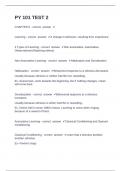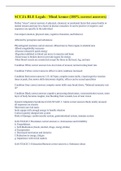-
1. Exam (elaborations) - Chapter 6 py101 question with complete solution
-
2. Exam (elaborations) - Dobias py101 final exam study guide question and answers rated a+
-
3. Exam (elaborations) - Psychology question and answers 100% correct
-
4. Exam (elaborations) - Py 101 question and answers already passed
-
5. Exam (elaborations) - Py 101 question and answers already passed
-
6. Exam (elaborations) - Py 101 question and answers correctly solved
-
7. Exam (elaborations) - Py 101 ch 1 question and answers correctly solved
-
8. Exam (elaborations) - Py 101 chapter 1 and 2 test questions with complete solution
-
9. Exam (elaborations) - Py 101 chapter 5 memory question and answers rated a+
-
10. Exam (elaborations) - Py 101 exam 1 question and answers 100% correct
-
11. Exam (elaborations) - Py 101 exam 1 question and answers already passed
-
12. Exam (elaborations) - Py 101 exam 1 question and answers verified to pass
-
13. Exam (elaborations) - Py 101 exam 1 question and answers correctly solved
-
14. Exam (elaborations) - Py 101 exam 1 questions with complete solution
-
15. Exam (elaborations) - Py 101 exam 1 study guide uab question and answers 100% correct
-
16. Exam (elaborations) - Py 101 exam 1 ua question and answers already passed
-
17. Exam (elaborations) - Py 101 exam 1 question and answers verified to passed
-
18. Exam (elaborations) - Py 101 exam 2 question and answers verified to pass
-
19. Exam (elaborations) - Py 101 exam 2 question and answers correctly solved
-
20. Exam (elaborations) - Py 101 exam 2 quizzes questions with complete solution
-
21. Exam (elaborations) - Py 101 exam 2 ua question and answers rated a+
-
22. Exam (elaborations) - Py 101 exam 2 ua question and answers 100% correct
-
23. Exam (elaborations) - Py 101 exam 2 question and answers already passed
-
24. Exam (elaborations) - Py 101 exam 2 question and answers already passed
-
25. Exam (elaborations) - Py 101 exam 2 question and answers verified to pass
-
26. Exam (elaborations) - Py 101 exam 3 question and answers correctly solved
-
27. Exam (elaborations) - Py 101 exam 3 question and answers correctly solved
-
28. Exam (elaborations) - Py 101 exam 3 questions with complete solution
-
29. Exam (elaborations) - Py 101 exam 3 ua question and answers rated a+
-
30. Exam (elaborations) - Py 101 exam 3 question and answers 100% correct
-
31. Exam (elaborations) - Py 101 exam 4 question and answers already passed
-
32. Exam (elaborations) - Py 101 exam 5 question and answers verified to pass
-
33. Exam (elaborations) - Py 101 exam question and answers verified to pass
-
34. Exam (elaborations) - Py 101 exam question and answers verified to pass
-
35. Exam (elaborations) - Py 101 final exam question and answers correctly solved
-
36. Exam (elaborations) - Py 101 final exam questions with complete solution
-
37. Exam (elaborations) - Py 101 final exam review question and answers rated a+
-
38. Exam (elaborations) - Py 101 final exam study guide question 100% correct
-
39. Exam (elaborations) - Py 101 final exam study question and answers 100% correct
-
40. Exam (elaborations) - Py 101 g question and answers 100% correct
-
41. Exam (elaborations) - Py 101 midterm review question and answers already passed
-
42. Exam (elaborations) - Py 101 quiz 1 question and answers verified to pass
-
43. Exam (elaborations) - Py 101 quiz 4 question and answers already passed
-
44. Exam (elaborations) - Py 101 quiz 5 question and answers verified to pass
-
45. Exam (elaborations) - Py 101 test 1 dobias question and answers verified to pass
-
46. Exam (elaborations) - Py 101 test 2 question and answers correctly solved
-
47. Exam (elaborations) - Py 101 questions with complete solution
-
48. Exam (elaborations) - Py 101 question and answers rated a+
-
49. Exam (elaborations) - Py 101 question and answers correctly solved
-
50. Exam (elaborations) - Py 101 questions with complete solution
-
51. Exam (elaborations) - Py 101 question and answers rated a+
-
52. Exam (elaborations) - Py 101 question and answers 100% correct
-
53. Exam (elaborations) - Py 101 question and answers 100% correct
-
54. Exam (elaborations) - Py 101 question and answers already passed
-
55. Exam (elaborations) - Py 101 question and answers already passed
-
56. Exam (elaborations) - Py 101 question and answers verified to pass
-
57. Exam (elaborations) - Py question and answers correctly solved
-
58. Exam (elaborations) - Py questions with complete solution
-
59. Exam (elaborations) - Py questions with complete solution
-
60. Exam (elaborations) - Py question and answers 100% correct
-
61. Exam (elaborations) - Py101 question and answers already passed
-
62. Exam (elaborations) - Py101 chapter three question and answers verified to pass
-
63. Exam (elaborations) - Py101 exam 1 question and answers verified to pass
-
64. Exam (elaborations) - Py101 exam 1 uab question and answers correctly solved
-
65. Exam (elaborations) - Py101 exam 1 question and answers rated a+
-
66. Exam (elaborations) - Py101 exam 3 question and answers verified to pass
-
67. Exam (elaborations) - Py101 exam 3 question and answers correctly solved
-
68. Exam (elaborations) - Py101 exam 6 personality question and answers correctly solved py101 exam 6 persona...
-
69. Exam (elaborations) - Py101 final question and answers correctly solved
-
70. Exam (elaborations) - Py101 final exam questions with complete solution
-
71. Exam (elaborations) - Py101 final exam question and answers rated a+
-
72. Exam (elaborations) - Py101 final exam question and answers 100% correct
-
73. Exam (elaborations) - Py101 final exam chap 11 question and answers 100% correct
-
74. Exam (elaborations) - Py101 final exam chapter 2 question and answers already passed
-
75. Exam (elaborations) - Py101 final exam review question and answers 100% correct
-
76. Exam (elaborations) - Py101 final exam study guide. question and answers already passed
-
77. Exam (elaborations) - Py101 final exam question and answers already passed
-
78. Exam (elaborations) - Py101 final semo study guide question and answers verified to pass
-
79. Exam (elaborations) - Py101 test 1 questions with complete solution
-
80. Exam (elaborations) - Py101 uab rothrock question and answers rated a+
-
81. Exam (elaborations) - Py101 questions with complete solution
-
82. Exam (elaborations) - Py101 question and answers rated a+
-
83. Exam (elaborations) - Semo question and answers 100% correct
-
84. Exam (elaborations) - Ua py 101 exam 4 question and answers already passed
-
85. Exam (elaborations) - Ua py 101 final exam question and answers already passed
-
86. Exam (elaborations) - Uab py101 ch 8 thinking and intelligence questions with complete solution
-
87. Exam (elaborations) - Uab py101 exam 1 dobias question and answers rated a+
-
88. Exam (elaborations) - Uab py101 final exam question and answers 100% correct
-
89. Exam (elaborations) - Uah py 101 final question and answers 100% correct
-
90. Exam (elaborations) - Uah py 101 zheng question and answers already passed
-
Show more





